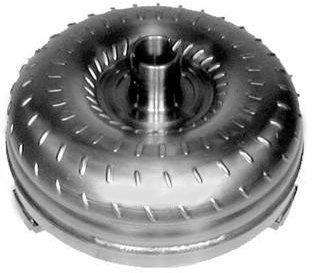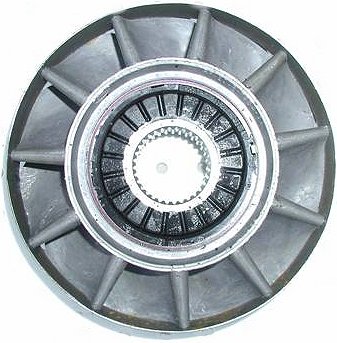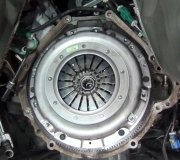The torque converter is designed to act as a fluid coupler that can engage and disengage with the increase and decrease of engine rpm. When the vehicle is not in motion while the engine is running the torque converter is in action. The torque converter converts fluid pressure to lock the converter output shaft. Once the shaft has locked the transmission receives engine power. At minimum engine rpm fluid pressure is low and the torque converter allows the engine to "freewheel" from the transmission.

Automatic Transmission Torque Converter
When the converter receives the power from the engine it transfers power to the transmission. The torque converter also has the ability to multiply torque when the engine is under power by multiplying fluid pressure through a component called a stator.

Torque Converter Stator
The stator allows the smooth transition from standing still to motion of the vehicle. The torque converter is filled with automatic transmission fluid pumped in from the fluid pump of the transmission. There is a measured amount of heat generated by the torque converter. This is why a transmission fluid cooler is necessary, usually installed inside the engine radiator. Most torque converters are equipped with a clutch that has the ability to lock up as the vehicles reaches cruising speeds. The clutch is activated by a fluid control solenoid inside the transmission that is activated by the computer. Transmission fluid passes through the torque converter and needs to be as clean as possible to ensure proper operation and limit malfunctions. Always observe manufacturers recommended transmission service intervals. If further technical assistance is needed, ask our team of certified car repair technicians.
Related Car Repair Information
- Torque Converter Questions
- How to Service an Automatic Transmission
- How to Remove an Automatic Transmission
- How an Automatic Transmission Works
- How to Check Transmission Fluid Level
Credits
This guide knowledge base was created by the 2CarPros Team, and by Ken Lavacot: Automobile repair shop owner and certified master automobile technician of over 30 years. If you have question or need help please ask one of our experts we are happy to help. Please visit our 2CarPros YouTube Channel.



